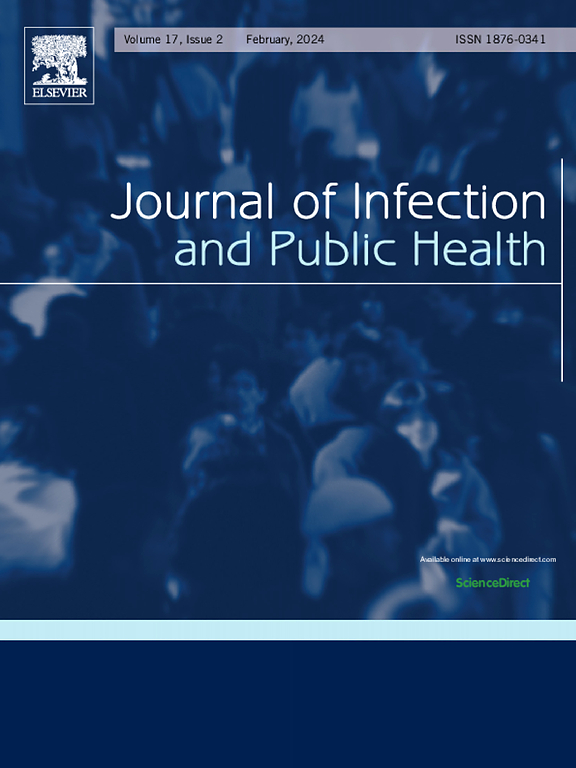结核分枝杆菌生物标志物在痰培养阴性临床参与者中的突出地位,独立于Ultra状态
IF 4.7
3区 医学
Q1 INFECTIOUS DISEASES
引用次数: 0
摘要
高灵敏度的分子检测如GeneXpert MTB/RIF Ultra提高了对少杆菌性肺结核(TB)的检测,但偶尔在培养阴性个体的痰中检测到结核分枝杆菌(MTB) DNA,其意义尚不清楚。我们假设Ultra可能检测到培养阴性结核病,并且与超阴性/培养阴性(“痰阴性”)个体相比,其结核病生物标志物的患病率更高。方法从1200名接受结核病评估的有症状的非洲成年人中,我们确定了66名结果不一致(超阳性,培养阴性),并匹配了52名痰阴性(超阴性,培养阴性)和30名痰阳性(超阳性,培养阳性)的参与者。在12个月的时间里,研究人员评估了参与者的结核分枝杆菌生物标志物(扩增或随访痰培养物中的结核分枝杆菌生长,基线痰中的结核分枝杆菌mRNA,基线后症状超阳性)和结核相关宿主转录特征。结果基线时,51.5 %的痰不一致者和59.6 %的痰不一致者(p = 0.46)检测到结核相关生物标志物,16.7 %和26.9 %分别检测到至少一个结核相关生物标志物(p = 0.26)。纵向上,尽管大多数报告症状改善,但未经治疗的痰不一致者中有26.5% %与未经治疗的痰阴性者中有41.7 %具有结核分枝杆菌生物标志物(p = 0.17)。值得注意的是,30 %未经治疗的痰阴性参与者在第2个月转为超阳性。随访时,一名痰检不一致者和一名痰检阴性者发展为培养证实的结核病。结论结核细菌和宿主生物标志物普遍存在,且痰液不一致和痰液阴性受试者之间无差异,这引起了对大量未确诊培养阴性结核病人群的关注。这些发现与痰培养阴性个体雾化结核杆菌的新证据相一致,并强调需要进行更全面的诊断,以检测痰培养阴性结核病的传染性、病理学和进展风险。本文章由计算机程序翻译,如有差异,请以英文原文为准。
Prominence of Mycobacterium tuberculosis biomarkers among sputum culture-negative clinic attendees, independent of Ultra status
Background
Highly-sensitive molecular tests like GeneXpert MTB/RIF Ultra improve detection of paucibacillary pulmonary tuberculosis (TB) but occasionally detect Mycobacterium tuberculosis (Mtb) DNA in sputum from culture-negative individuals, with unclear significance. We hypothesized that Ultra may be detecting culture-negative TB, and manifest in a higher prevalence of TB biomarkers compared to Ultra-negative/culture-negative (‘sputum-negative’) individuals.
Methods
From 1200 symptomatic African adults undergoing evaluation for TB, we identified 66 with discordant results (Ultra-positive, culture-negative), and matched 52 sputum-negative (Ultra-negative, culture-negative) and 30 sputum-positive (Ultra-positive, culture-positive) participants. Over 12 months, participants were assessed for Mtb biomarkers (Mtb growth in augmented or follow-up sputum cultures, Mtb mRNA in baseline sputum, and symptomatic Ultra-positive after baseline) and TB-associated host transcriptional signatures.
Results
At baseline, TB-associated biomarker(s) were detected in 51.5 % of sputum-discordant versus 59.6 % of sputum-negative participants (p = 0.46), with at least one Mtb biomarker in 16.7 % versus 26.9 % respectively (p = 0.26). Longitudinally, 26.5 % of untreated sputum-discordant versus 41.7 % of untreated sputum-negative participants had Mtb biomarkers (p = 0.17) despite most reporting symptom improvement. Notably, 30 % of untreated sputum-negative participants converted to Ultra-positive at month 2. One sputum-discordant and one sputum-negative participant developed culture-confirmed TB at follow-up.
Conclusion
TB bacterial and host biomarkers were prevalent and no different between sputum-discordant and sputum-negative participants, raising concern for a considerable population of undiagnosed culture-negative TB. These findings parallel new evidence of Mtb aerosolization from sputum-negative individuals and highlight a need for more comprehensive diagnostics that detect sputum culture-negative TB with respect to infectiousness, pathology, and risk of progression.
求助全文
通过发布文献求助,成功后即可免费获取论文全文。
去求助
来源期刊

Journal of Infection and Public Health
PUBLIC, ENVIRONMENTAL & OCCUPATIONAL HEALTH -INFECTIOUS DISEASES
CiteScore
13.10
自引率
1.50%
发文量
203
审稿时长
96 days
期刊介绍:
The Journal of Infection and Public Health, first official journal of the Saudi Arabian Ministry of National Guard Health Affairs, King Saud Bin Abdulaziz University for Health Sciences and the Saudi Association for Public Health, aims to be the foremost scientific, peer-reviewed journal encompassing infection prevention and control, microbiology, infectious diseases, public health and the application of healthcare epidemiology to the evaluation of health outcomes. The point of view of the journal is that infection and public health are closely intertwined and that advances in one area will have positive consequences on the other.
The journal will be useful to all health professionals who are partners in the management of patients with communicable diseases, keeping them up to date. The journal is proud to have an international and diverse editorial board that will assist and facilitate the publication of articles that reflect a global view on infection control and public health, as well as emphasizing our focus on supporting the needs of public health practitioners.
It is our aim to improve healthcare by reducing risk of infection and related adverse outcomes by critical review, selection, and dissemination of new and relevant information in the field of infection control, public health and infectious diseases in all healthcare settings and the community.
 求助内容:
求助内容: 应助结果提醒方式:
应助结果提醒方式:


